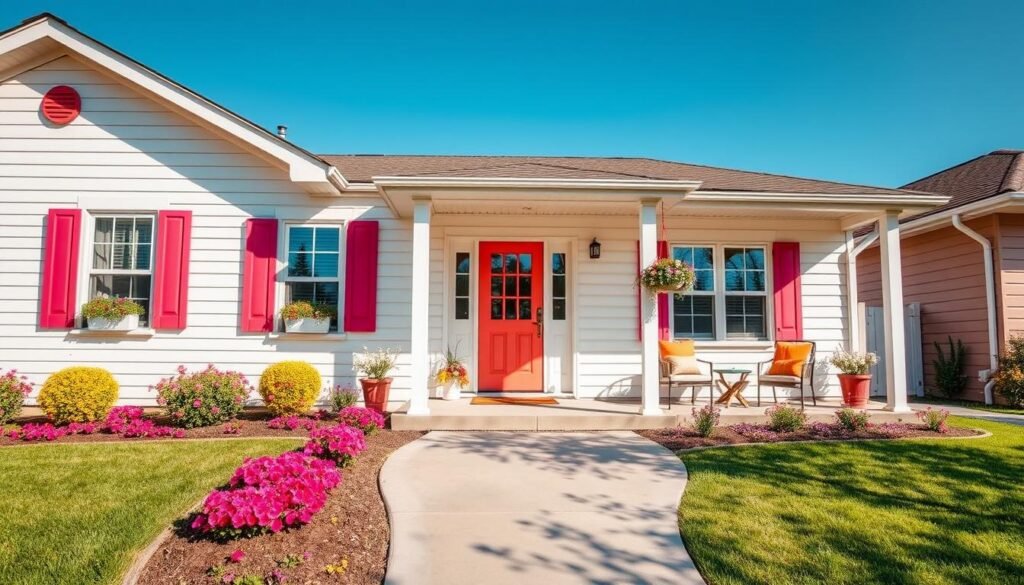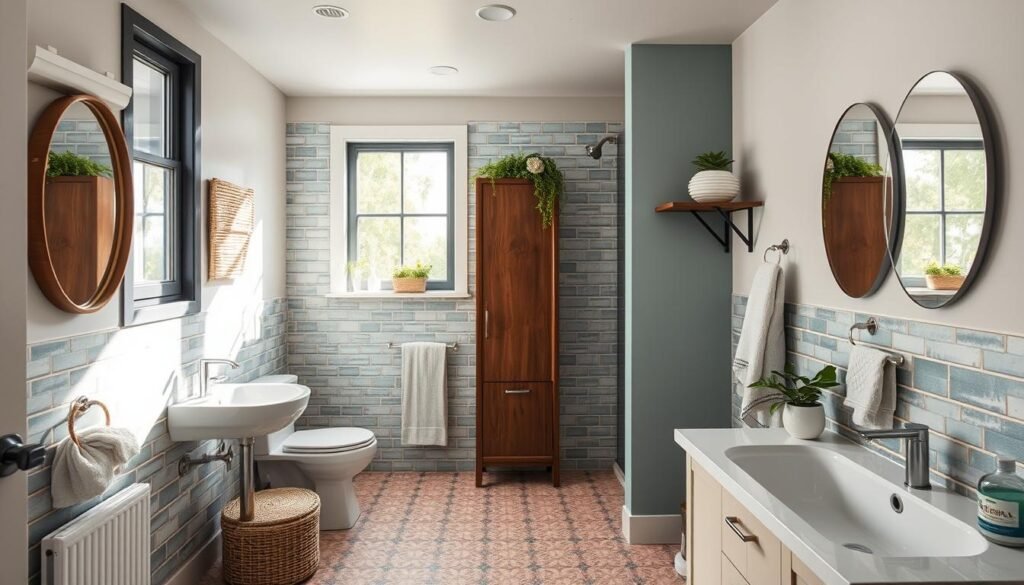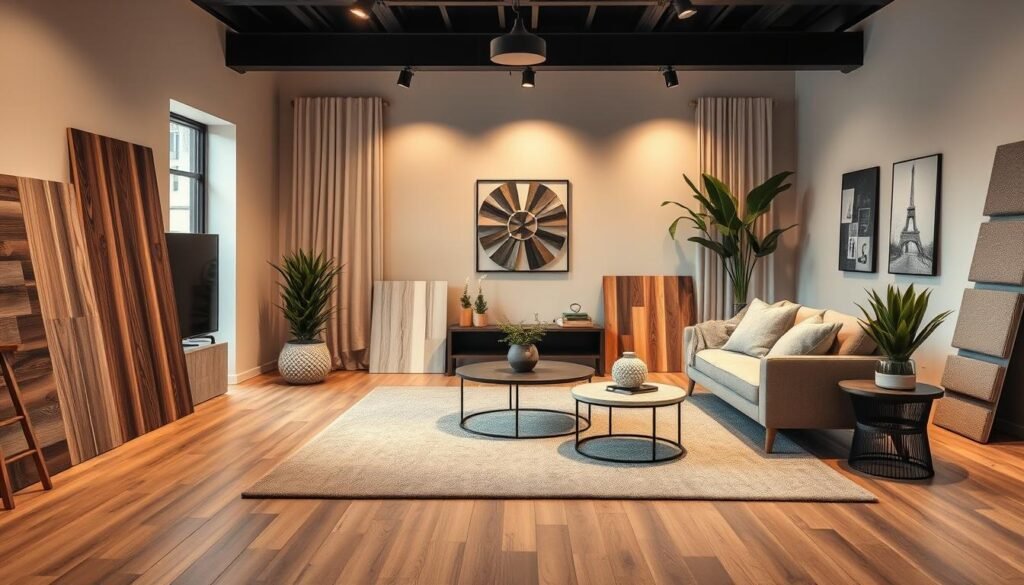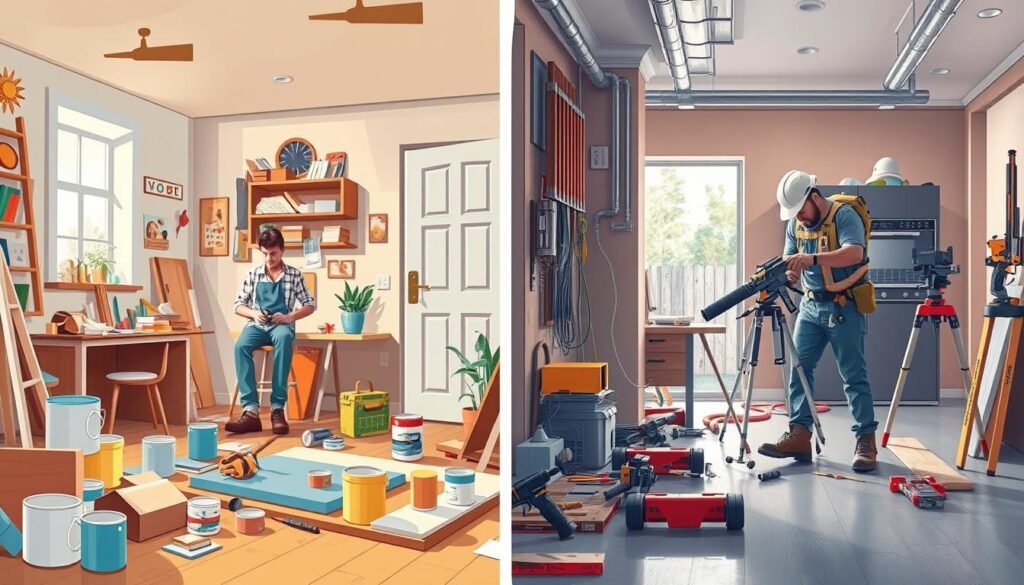Starting as a first-time investor can be daunting. But, with creativity and planning, you can make your rental shine without spending a lot. Focus on key, affordable updates that draw in good tenants and boost your investment return.
Imagine walking into a renovated space that catches your eye. It’s not just a dream. With the right low-cost remodeling tips, you can make it real. Whether it’s one room or the whole house, aim for the biggest impact with your budget.
Key Takeaways
- Prioritize low-cost remodeling tips to transform your rental property without breaking the bank
- Strategically plan your renovations to maximize return on investment (ROI)
- Explore budget-friendly solutions for kitchens, bathrooms, and curb appeal to attract quality tenants
- Leverage DIY projects and affordable materials to elevate your property’s style and functionality
- Stay informed on the latest trends and best practices to make the most of your home improvement budget
Understand Your Investment Goals
Before starting your real estate investing journey, it’s key to know your goals. Are you looking to flip a fixer-upper or get a rental property for passive income? Your goals will shape the home makeovers you focus on and the market you aim to reach.
Define Your Budget
Having a clear budget is vital for any real estate investing project. Think about your financial resources and how much you can spend on remodeling. This will help you choose the right upgrades and make smart decisions that fit your investment plan.
Identify Target Market
Finding your target market is crucial. Are you targeting first-time homebuyers, young families, or seasoned investors? Knowing your audience will guide your design choices and features, aiming to boost appeal and return on investment.
Set Clear Objectives
With your goals, budget, and market in mind, set clear objectives for your project. Decide on the upgrades and improvements you want to make. Prioritize them based on their value and market appeal. This will keep you focused and on track during the renovation.
| Key Considerations | Potential Benefits |
|---|---|
| Curb Appeal | Increased perceived value and higher selling price |
| Energy Efficiency | Reduced operating costs and enhanced buyer appeal |
| Kitchen Upgrades | Significant return on investment and buyer’s top priority |
| Bathroom Makeover | Improved aesthetics and added functionality |
| Additional Space | Increased living area and property value |
| Interior Painting | Refreshed look and increased appeal to potential buyers |
“Clearly defining your investment goals, budget, target market, and specific objectives is the foundation for a successful real estate investing project. This strategic planning will guide your remodeling decisions and ensure a strong return on your investment.”
Planning Your Remodeling Project
Starting a home renovation project is both exciting and challenging. To make sure your DIY efforts succeed, you need a solid plan. A detailed timeline, organized tools, and the right permits are key to avoiding mistakes and keeping your project on track.
Create a Timeline
First, make a realistic timeline for your project. Think about the work’s scope, material availability, and possible delays. Divide the project into smaller parts, giving each enough time. This helps you stay organized and on schedule, reducing daily life disruptions.
Organize Essential Tools
Get all the tools and materials you need before starting. This includes power tools, hand tools, safety gear, and special items. A well-stocked and organized workspace makes the renovation smoother, letting you work efficiently without interruptions.
List Necessary Permits
Find out which permits you need based on local building codes and regulations. The right permits ensure your work meets safety standards and avoids fines or issues later. Some tasks, like painting or flooring updates, might not need permits. But bigger projects, like adding rooms or changing structures, usually do.
Good planning is crucial for DIY projects and home renovations. Stay organized, plan for obstacles, and use available resources. This way, you can turn your home into your dream space.
| Renovation Task | Permit Required |
|---|---|
| Painting | No |
| Replacing Flooring | No |
| Adding a New Room | Yes |
| Upgrading HVAC System | Yes |
| Changing Roofline | Yes |
Start with a Fresh Coat of Paint
A fresh coat of paint can make a big difference in a room’s look. It’s a great way to update a space without spending a lot. Whether you’re flipping a house or improving a rental, paint is a smart choice.
Choose Trending Colors
Staying current with color trends can make your space look modern. Neutral colors like grays, beiges, and whites are always in style. They create a calm and versatile background.
If you want to add some personality, try colors like sage green or deep blues. Even bold colors like mustard or terracotta can work well as accent walls.
Consider Accent Walls
An accent wall can really change a room’s look. Painting one wall in a different color or using a bold wallpaper adds interest. It’s a simple way to improve a room’s look without spending a lot.
Techniques for DIY Painting
Painting can be easy, even if you’re on a tight budget. Try using sponges or rags to create unique textures. This can save you money on professional painters.
With a bit of practice, you can get professional-looking results. This way, you can update a space without spending too much.
“A fresh coat of paint can completely transform the look and feel of a space, making it a must-do for any interior design on a budget.”
| Key Statistics | Insights |
|---|---|
| Renters are more exposed to home decor trends due to popular shows on HGTV and the DIY Network. | Keeping up with the latest color trends can help create a modern and appealing aesthetic for rental properties. |
| A clean rental property can attract more tenants. | A fresh coat of paint can make a significant difference in the overall appearance and appeal of a rental property. |
| Regularly updating paint colors can keep a property appealing to renters. | Incorporating trending colors and techniques like accent walls can help maintain the visual interest and desirability of a rental property. |
Upgrade Your Curb Appeal
Your home’s exterior is key to making a lasting first impression. Simple, affordable upgrades can boost your property’s value and appeal. Refreshing your landscaping and revitalizing your front door are great ways to transform your home’s outside without spending a lot.
Simple Landscaping Ideas
Start by sprucing up your landscaping. Use native plants, shrubs, and flowers that do well in your area. Refresh the mulch around your plants and trees for a polished look. Consider a new walkway or updating your current one with pavers or natural stone for elegance.
Front Door Makeovers
Your front door is the home’s exterior focal point. A fresh coat of paint or updated hardware can make a big difference. Choose a bold color to stand out or a neutral tone to match your home’s siding and trim. Adding a new door knocker, house numbers, or a wreath can also enhance your home’s look.
Lighting Enhancements
Outdoor lighting is key for safety and looks. Upgrade to energy-efficient LED fixtures along walkways, driveways, and porches. Landscape lighting can highlight your home’s features and create a warm atmosphere, improving visibility and security.
By focusing on these simple, affordable upgrades, you can improve your home’s curb appeal. This makes your home more attractive to potential buyers and adds value to your investment.

Focus on Kitchen Improvements
The kitchen is often the heart of the home. Making it better doesn’t have to cost a lot. Let’s look at some ways to improve your kitchen without spending too much.
Affordable Cabinet Solutions
Refacing or painting your cabinets can change your kitchen. Refacing means new doors and fronts but keeps the old boxes. It’s cheaper than new cabinets. Or, just paint them to match your style.
Budget-Friendly Countertops
Laminate and butcher block countertops are cheap but stylish. Laminate looks like expensive materials but costs less. Butcher block is warm and can be refinished, lasting long and saving money.
Cost-Effective Backsplash Options
A colorful backsplash can change your kitchen’s look without spending a lot. Try peel-and-stick tiles or painted beadboard. They’re easy to put up and perfect for DIY projects.
With these affordable kitchen updates, you can make a big difference. Small changes can have a big impact. So, get creative and find ways to make your kitchen look great without spending a lot.
Revamp the Bathroom Space
Bathroom renovations can seem scary, but they don’t have to be expensive. Whether you’re new to home improvement or have done it before, you can make your bathroom look new without spending a lot. Check out [https://frankraspante.org/properties/] for affordable ideas.
Affordable Fixture Updates
Begin by updating your fixtures. New faucets, showerheads, and lights can change your bathroom’s look. Choose energy-saving and quality items that won’t cost too much. LED lights, for instance, are cheap and make your bathroom look better and use less energy.
Creative Storage Solutions
Use smart and cheap ways to add storage. Try floating shelves, over-the-toilet storage, or old furniture repurposed. These ideas can greatly improve your bathroom’s look and function without big changes.
Shower and Tub Alternatives
If you can’t afford new tubs or showers, think about cheaper options. Refinish your tub or get a prefab shower unit. These choices can update your bathroom without the high cost of new plumbing.
With these budget-friendly updates, you can give your bathroom a fresh, modern look without spending a lot. [https://frankraspante.org/properties/] Remember, small changes can make a big difference. So, be creative and explore your options.

Maximize Living Space
When it comes to interior design on a budget, making the most of your space is crucial. Open concept designs and smart furniture choices can transform your home affordably. Mirrors can also make your space look bigger and more open.
Open Concept Designs
Removing non-load-bearing walls can make your living area feel more open and inviting. This simple change can make your space look better and feel more welcoming. It also helps you move easily between rooms, creating a sense of openness.
Smart Furniture Choices
Choose furniture that does more than one thing. Look for items like storage ottomans, convertible sofas, and nesting tables. These pieces save space and money by doing multiple jobs.
Use of Mirrors
Mirrors can make a room look bigger and brighter. Place mirrors across from windows to reflect light, or opposite each other to add depth. This trick is easy on the wallet but makes a big difference in how your space feels.
Using these space-saving tips can change your home without expensive updates. Whether you’re starting fresh or updating your space, these ideas can make your home warm, inviting, and stylish without breaking the bank.
Frank Raspante is a top real estate expert known for his budget-friendly interior design solutions. His approach has helped many clients achieve their goals without overspending.
| Renovation Strategies | Estimated Cost Savings |
|---|---|
| Open Concept Designs | Up to 20% reduction in construction costs |
| Multifunctional Furniture | 30-50% savings on furniture expenses |
| Strategic Mirror Placement | Negligible cost, high impact on perceived space |
“Transforming your living space doesn’t have to mean a complete overhaul. By focusing on smart space optimization and budget-friendly interior design solutions, you can create a truly remarkable home that reflects your unique style and lifestyle.”
– [https://frankraspante.org/about/]
Flooring Options on a Budget
Flooring can be very expensive in home renovations. But, with some creativity and smart shopping, you can update your space without spending a lot. Let’s look at some affordable flooring options that can make your home look great while keeping costs down.
Affordable Materials to Consider
Vinyl flooring is a great choice because it’s affordable, water-resistant, and lasts long. Luxury Vinyl Plank (LVP) looks like wood, stone, or exotic materials but costs less. Vinyl sheets are also a budget-friendly option that looks seamless.
Laminate flooring is another good choice. It can last 15-25 years and is easy to maintain. Ceramic and porcelain tiles are durable and can last decades. They come in many designs and are good for busy areas.
DIY Installation Tips
Installing flooring yourself can save a lot of money. Materials like luxury vinyl plank and laminate are easy to install. Doing it yourself means you save on labor costs.
To do a good job, measure your space right, prepare the subfloor well, and follow the manufacturer’s instructions. With patience and care, you can update your floors without needing a professional.
Maintaining Flooring Quality
Keeping your floors in good shape is important, no matter the material. Regular cleaning helps them look good and last longer. For spills, clean them up quickly to avoid damage.
Choosing affordable, durable flooring and doing the installation yourself can give your home a new look without spending too much. Budget-friendly renovations not only make your home better but can also increase its value. It’s a smart investment for the future.
| Flooring Material | Average Cost per Square Foot | Key Features |
|---|---|---|
| Laminate | $2 – $7 | Durable, water-resistant, easy to install |
| Vinyl Plank | $2 – $7 | Waterproof, scratch-resistant, realistic wood-like appearance |
| Ceramic Tile | $5 – $10 | Durable, easy to clean, versatile design options |
| Porcelain Tile | $2 – $25 | Highly durable, water-resistant, color-fast |
| Concrete | $2 – $8 | Customizable, long-lasting, budget-friendly |

“Budget-friendly renovations can enhance a home’s energy efficiency, leading to reduced monthly utility bills.”
Lighting: The Game Changer
Lighting is key to changing your home’s look and feel. It can make any space brighter and more welcoming. This makes it a must-have for your home makeover.
Incorporating Natural Light
First, let’s use more natural light. Remove heavy curtains or add skylights. This lets more sunlight in, making rooms brighter and more inviting. It also means you use less artificial light, saving energy.
Budget-Friendly Fixture Updates
Changing your lighting fixtures can make a big difference without costing a lot. Look for deals at discount stores or online. Affordable options like sleek pendant lights or modern floor lamps can make your home look new.
Smart Lighting Solutions
Try smart lighting like LED bulbs or dimmer switches. They save energy and let you control the mood. Whether it’s for a cozy movie night or a big party, you can set the perfect lighting.
Lighting can change your home’s look and feel without big renovations. Use natural light, update fixtures on a budget, and add smart lighting. The right lighting can truly transform your home.
Make Small Changes, Big Impact
Small updates can make a big difference in remodeling on a budget. As a first-time investor, choosing affordable upgrades and sustainable decor can refresh your property. You won’t have to spend a lot of money.
Hardware Upgrades
Upgrading cabinet and door hardware is an easy way to refresh your home. Replacing old knobs, pulls, and hinges with new, affordable ones can change the look of your kitchen, bathrooms, and more. Doing this yourself can save you money, as builders often charge more for these details.
Sustainable Decor Choices
Adding sustainable decor to your remodel is good for the environment and adds character. Think about using vintage furniture, upcycling thrift store items, or choosing eco-friendly textiles and accessories. These small changes can have a big effect without costing too much.
Reorganizing Spaces
Changing how you arrange furniture and decor can transform a room. Try out different layouts and ways to organize your space. Simple changes, like adding shelves, rearranging furniture, or using pieces that serve more than one purpose, can greatly improve your home’s look and feel.
By focusing on these small, budget-friendly updates, you can make a big difference in your investment property. Remember, it’s often the little things that can attract renters or buyers and increase your home’s value.
The Power of Staging
In the world of real estate investing, first impressions are key. Home staging is all about making a great first impression. It involves arranging furniture, accessories, and decor to make a space inviting and eye-catching.
Techniques for Effective Staging
Good home staging is more than just cleaning up and moving things around. It’s about making a space feel warm and welcoming. Key techniques include:
- Using neutral colors to appeal to more people
- Showing off natural light and open spaces
- Adding trendy decor and accents
- Highlighting special features of the property
Cost-Efficient Staging Tips
While hiring a pro can cost money, you can stage your home on a budget. Try these DIY ideas:
- Declutter and deep clean for a fresh feel
- Move furniture to improve flow and use
- Add simple decor like throw pillows and plants
The Importance of First Impressions
In the competitive world of home staging, making a good first impression is crucial. Buyers or renters decide quickly. Good staging can make your property stand out, leading to more interest, faster sales, and better returns.
| Staging Metric | Impact |
|---|---|
| Homes with virtual staging sell 78% faster | Increased sales velocity |
| Staged homes sell for 19% higher prices | Higher returns on investment |
| Virtual staging reduces costs by up to 97% | Cost-efficient solutions |
Learning home staging can boost your real estate investing. Start making a better first impression today.
“Proper staging can significantly increase the perceived value of your investment property.”
DIY vs. Hiring Professionals
Choosing between DIY projects and hiring pros can affect your budget, timeline, and final quality. As a first-time investor, knowing when to DIY and when to hire pros is key.
When to DIY
DIY projects can save money and teach you new skills. Tasks like painting, updating hardware, or installing lights are good for DIY. Doing it yourself lets you customize your space and learn to appreciate your home more.
Finding Reliable Contractors
For complex projects, hiring professional remodeling contractors is best. Look for experienced, licensed, and insured pros with good references and a portfolio. Researching and vetting helps find the right team for your vision.
Budgeting for Professional Help
While DIY saves money, sometimes pros are worth the cost. For big kitchen or bathroom makeovers, structural changes, or electrical/plumbing work, pros are needed. Budgeting for pros ensures your project’s quality and value.
By balancing DIY and professional help, you can manage your budget and achieve your remodeling goals. Stay informed, explore your options, and ask for help when needed.
| DIY Projects | Professional Remodeling |
|---|---|
| Painting | Kitchen/Bathroom Renovations |
| Hardware Upgrades | Structural Changes |
| Light Fixture Installation | Electrical/Plumbing Work |

A smart mix of DIY home improvement and professional remodeling can help you reach your investment goals. It optimizes your budget and timeline.
Understanding Return on Investment (ROI)
As a real estate investor, it’s key to think about ROI when planning home improvements. By measuring the impact of your upgrades, you can focus on investments that boost your property’s value. This way, you get the best returns.
Measuring Your Upgrades
To see the ROI of your remodeling, track changes in rental income, occupancy rates, and market value. Keep records of costs and benefits. This helps you find the most effective upgrades for future projects.
Visual Appeal vs. Functionality
Home improvements need a balance between looks and function. Upgrades that make your property look better can attract tenants or buyers. But, improvements that make life easier, like energy-efficient appliances, also add value. Think about both to get the best ROI.
Long-Term Value Considerations
Think about the long-term value of your upgrades. Things like hardwood floors, granite countertops, or new roofs add lasting value. Focus on these to get the most from your investment and keep your property valuable over time.
| Upgrade | Average ROI |
|---|---|
| Kitchen Remodel | Up to 15% |
| Bathroom Renovation | 10% |
| Hardwood Floors | Increased Resale Value |
| Granite Countertops | Increased Resale Value |
| Energy-Efficient Windows | Reduced Energy Costs |
| Solar Panels | Reduced Energy Costs, Increased Resale Value |
Understanding your home improvement ROI helps you make smart choices. These choices not only make your property look good but also increase its value over time. This strategy is crucial in real estate investing and getting the best home improvement ROI.
Sustainability: Remodeling Wisely
Being eco-conscious is now essential in home improvement. As a first-time investor, you can make your projects sustainable. This leads to cost savings and higher property value. Let’s look at how you can make a difference.
Eco-Friendly Materials
Start by choosing eco-friendly materials. Look for bamboo flooring, recycled glass tiles, or cork countertops. These options are good for the planet and add elegance to your home.
Energy-Efficient Solutions
Boosting your home’s energy efficiency is a wise move. Consider getting ENERGY STAR appliances, better insulation, or energy-saving windows. These changes cut down on bills and help the environment.
Reducing Waste in Remodeling
- Recycle materials like wood, metal, and plastic.
- Choose durable products that last longer.
- Work with contractors who reduce waste and dispose responsibly.
By focusing on sustainable home improvement, you create a greener, more efficient space. Plus, you boost your investment’s value. Remember, even small changes can have a big impact on sustainable home improvement and energy-efficient upgrades.
“Sustainable remodeling is not just about doing the right thing – it’s a smart investment that pays off in the long run.”
Final Touches that Elevate
As you finish your remodeling project, the final touches really make a difference. They boost your home’s decor and curb appeal. These steps can greatly improve your home’s value without costing much more.
Choosing the Right Decor
Choosing the right decor is key to a cohesive look. Pick trendy yet timeless pieces that match your home’s new look. Add statement accessories like decorative vases or a stunning chandelier to add elegance and personality.
Accessories That Make a Statement
Accessories can change a room’s feel and improve your home’s design. Choose high-quality items that look good and work well. Luxurious textiles like area rugs or curtains make a room cozy. Mirrors can also make a room look bigger and brighter.
Landscaping for Continued Appeal
Don’t forget about your home’s exterior. Simple landscaping can make a big difference. Plant colorful flowers, trim hedges, and keep the lawn looking great. These small steps can greatly enhance your home’s look and value.
The final touches are like the icing on a cake. They elevate your remodeling and make your home more appealing. By picking the right decor, accessories, and landscaping, you can make your property stand out.
Conclusion: Start Your Remodeling Journey Today
Your journey in remodeling your investment property is just starting. You have a lot of possibilities ahead. With the budget-friendly tips you’ve learned, you can start your home improvement journey with confidence. You’ll turn your space into a gem and increase your returns.
Keep Learning and Adapting
Remember, remodeling is always changing. As you work on each project, keep learning and adapting. Stay up-to-date with new design trends, materials, and cost-saving ideas. See challenges as chances to grow and improve your skills.
Celebrate Your Progress
Don’t forget to celebrate your wins, no matter how small. Every finished project and value increase shows your hard work. Enjoy the pride of seeing your property improve under your care.
Stay Inspired for Future Projects
With your new knowledge and confidence, look for more opportunities. Keep exploring new home improvement journey ideas and investment property success strategies. Always find ways to make your properties better, more appealing, and fully potential.